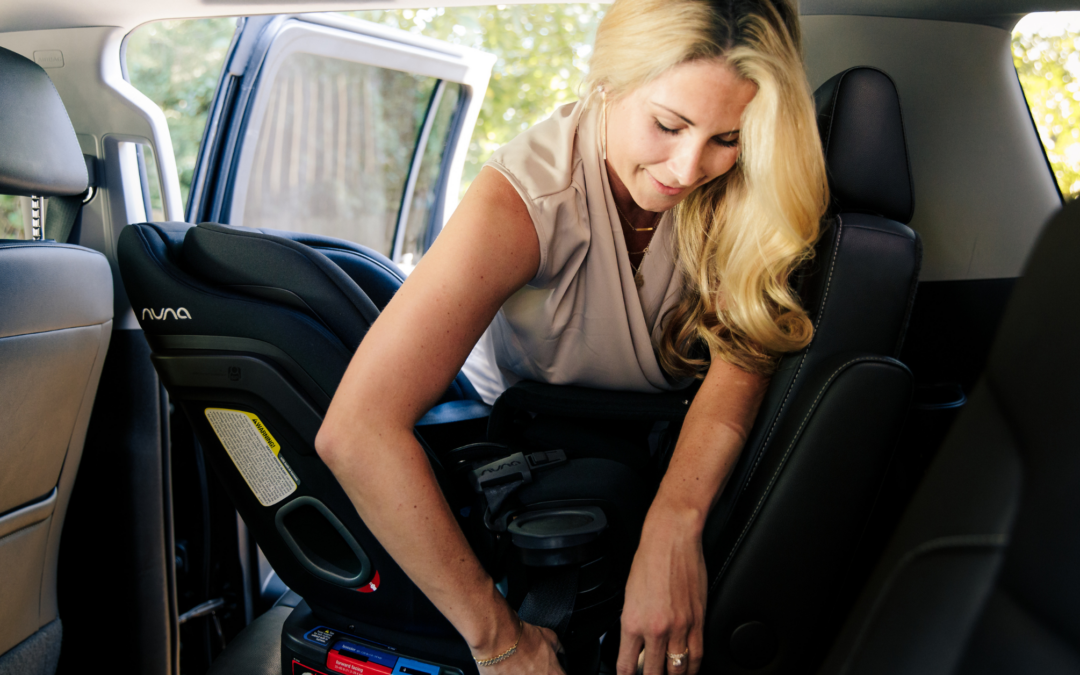A car seat holds and protects your most precious cargo. Whether it’s your baby’s first car ride home or you’ve just joined the car seat safety conversation, understanding how the seat’s features protect your baby in a crash is super important. Not only will this give you peace of mind, but it’ll also help you make informed decisions about every stage of your child’s car seat journey.
So, today, we’ve dedicated our post to car seat safety features! We’ll be discussing 11 safety features you may come across when car seat shopping. Some come standard on every child safety restraint system, while others are more of an add-on feature. It’s our hope that you will find this information helpful when buying a new car seat and beyond!
Here are the top 11 features that help keep your child shielded from harm:
11 Car Seat Safety Features
Five-Point Harness System
One of the foundations of car seat safety is the five-point harness system. You can identify this feature by the two harness straps that connect at the shoulders, crotch, and hips. This is easy for parents to locate in the United States because 5-point harness systems are the only harness systems allowed on the market!
This system maintains the proper upright position while also keeping the straps positioned appropriately on the child. Even with the jostling or whiplash from a crash, your child would be restrained by the harness, which also serves to absorb some of the energy of a crash impact. When buckled correctly, this is one of the most powerful safety tools on your seat.
LATCH System
LATCH stands for Lower Anchor and Tethers for Children, and it’s standard in passenger vehicles since 2002! There is a metal bar inside the vehicle seat, with hooks that are available between the seat cushions. When your child is under a certain weight, you can use these hooks to easily install your car seat into the vehicle! (Check your manual for weight limits.)
This system can be easier than seatbelt installation for some car seats. And it’s just as safe as the seatbelt method when you use it correctly! However, you can only use it under a certain weight limit and in a designated location in the vehicle. So it’s important to get those factors right when choosing LATCH install!
Check out this YouTube video on How to use Lower Anchor Connectors.
Seatbelt Integration
Once your child has outgrown the LATCH system, or you simply don’t want to go with that installation method, it’s time to utilize seat belts. Car seats can be safely installed with the lap belt and shoulder belt locked and threaded through the correct belt path within the seat. This is the way your child passengers will ride for most of their car seat journey!
When the car seat is secured in the embrace of the seatbelt, it’s just as secure as the LATCH system. And since there are so many restrictions on LATCH install, seatbelt install is a safe choice at any weight or seating location!
Top Tether Strap
When your child moves from the rear-facing car seat position to the front-facing position, you must attach the top tether strap. These tethers connect to a hook embedded in the back of the vehicle seat, on the rear dash of a sedan, or sometimes on the vehicle roof.
The top tether strap prevents the top of your car seat from tipping forward in a crash. That means your child won’t whip forward in an accident, either. They’ll stay hugged to the car seat, and the car seat will stay hugged to the vehicle seat. Without the top tether, your child’s head can fly forward an extra six inches, which can lead to head strike injuries. Don’t forget to attach this tether strap when you make the translation to the front-facing position.
Most of the time, the top tether is only used in the forward-facing position. But a few seats now offer rear-facing top tether options! Rear-facing top tethers can limit how far the rear-facing car seat rotates towards the front of the vehicle during a crash, absorbing lots of that crash energy away from your child. Seats like the Uppababy Knox have a rear-facing top tether feature, and Clek offers an added accessory called the Q-tether for the Foonf and Fllo to achieve the same effect!
Clek Foonf review: read here.
How to install Clek Foonf rear-facing: YouTube Video
How to install Clek Foonf forward-facing: YouTube Video
Side-Impact Protection
Car seats with side-impact protection have plastic, metal, and foam that distribute crash force, keeping your baby safe. The side of the car seat usually protrudes to shield the baby’s body as much as possible. Side impact protection may be built into the car seat shell, or it may require an extra step, like extending a special pod on the door side of the car seat. This is an important safety feature because though collisions usually happen to the rear or front of the car, they can happen to the sides too!
Expanded Polystyrene (EPS) or Expanded Polypropylene Foam (EPP)
The padding used in car seats isn’t just to keep your baby comfortable, but it also keeps them safe. The foam under the cover of many car seats helps to absorb and distribute crash force.
Adjustable Recline Mechanism
The safe recline on a car seat changes as a child grows. An infant will need to be at a greater recline than a five-year-old to support the baby’s head and protect their airway. The recline on a rear-facing car seat also plays a role in crash energy absorption. The adjustable recline function on many car seats allows you to get the proper angle for your child throughout their whole car seat career.
anti-rebound bar
In most crashes, the first movement will throw all the occupants and car seats toward the front of the vehicle with huge amounts of force. And we all remember from high school physics (yes, physics! Sorry!) that every action has an equal and opposite reaction. In a car crash, this means that after that initial impact, there is a rebound, or “bounce back” effect. For a rear-facing car seat, this rebound can involve a whole lot of movement! An anti-rebound bar limits this movement by bracing against the vehicle seat back. An ARB can also limit the rotation of the car seat in a side-impact crash. Limiting movement and absorbing more energy is great, and ARBs do just that!
See our YouTube video What happens in a car crash? for the visual.
load leg
The load leg has a similar function to the anti-rebound bar, but the process is different. A load leg braces a car seat against the vehicle floor and prevents the car seat from vaulting toward the front of the car, which is the initial movement during a crash. This absorbs a significant amount of crash energy. Since the movement forward is limited, the rebound toward the vehicle seat is less severe. Of course, this makes your child safer in their seat. The less movement, the better! Lots of infant car seat bases offer a load leg, and one convertible car seat, the Cybex Sirona S, offers this noteworthy safety feature.
Instruction Manual
The final safety feature on your car seat is your instruction manual! It holds all of your safety seat’s specific standards, like the max weights and heights for each mode, proper installation instructions, and fit guides. These directions come right from the car seat manufacturer, who knows the seat best!
Information about car seats on the internet will be pretty general since there are so many car seats out there. However, with an instruction manual, there is no question about how long your child should ride in a rear-facing position or whether the LATCH system can still be in use. The manual tells all!
Additionally, a car seat instruction manual usually includes a car seat registration form. When you turn this in, you get up-to-date information on any recalls or dangers related to your child’s seat. The manual is not something you toss out, like the instructions for your child’s last birthday present. This is an integral part of your seat’s safety!
Properly utilized car seats are built to keep your child safe in a crash!
Car seats are one of the most important pieces of gear you’ll buy for your baby. They keep your children safe while you head out on the dangerous roadways. We know it’s inevitable that you’ll need to drive your child from place-to-place, so give them the best protection possible by fastening them in the proper safety seat.
If you’re unsure of what kind of seat your child should have, check out this article. And browse our blog and Instagram for more information on common car seat mistakes like improper buckling, installation, and driving practices. If you still have questions, don’t hesitate to hire one of our own certified child passenger safety technicians. We’re here to help you keep your child safe in their seat!
Affiliate links are included above. Safe in the Seat earns a small commission when you purchase through these links with no cost to you. We so appreciate your support.

